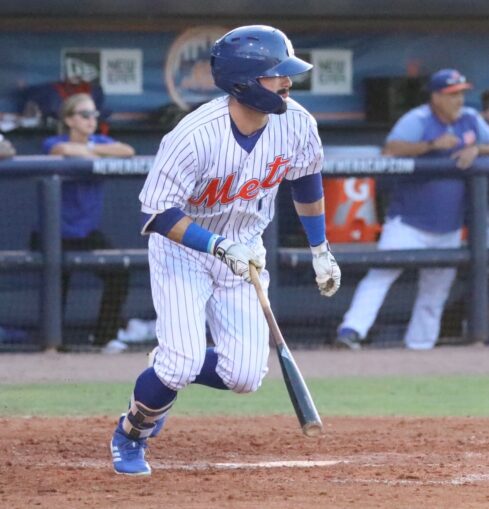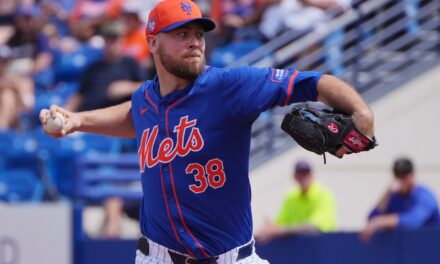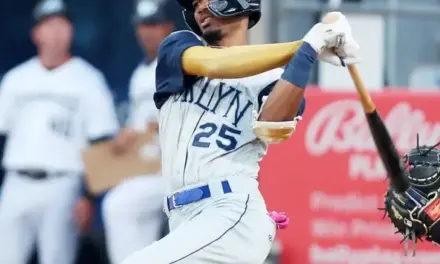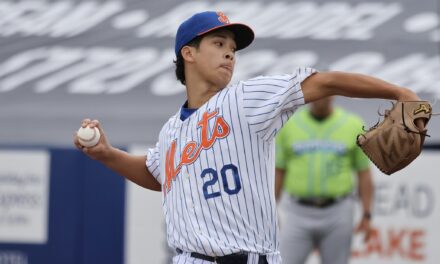
Quinn Brodey. Photo by Ed Delany, MMO
Last season was not what either Quinn Brodey nor Manny Rodríguez hoped it would be. Brodey had a slash line of .193/.375/.612 across 186 games between Double-A and Triple-A and Rodríguez had a nearly identical line of .179/.352/.562. Quinn’s struggles at the plate had to be frustrating for the New York Mets as he received a $500,000 bonus in 2017 and had reached an age where his potential was essentially his current ability.
He did, however, have experience at Stanford as a pitcher, accumulating 42 innings pitched in the 2015 season between spring and summer as a left-handed thrower. It was a no-brainer for the Mets to at least give him a try on the mound and see if they could recoup some more of their investment.
Rodríguez, on the other hand, had just one out recorded on the mound in his career but hit 93 mph in a bullpen session in Binghamton (Double-A) last season. This led the Mets to think that there was potential for him on the bump too.
After months of working down at the complex in St. Lucie, each player started developing some consistency and differing pitch shapes. It took Rodríguez a long time to learn a slider and Brodey struggled to find his velocity, but, eventually both started to look like professional pitchers.
Rodríguez got a taste of action in the complex league last summer, struggling with his command as he issued five walks in just 2 2/3 innings. After an additional offseason of working, Brodey broke camp with High-A Brooklyn, and Manny was initially on the Florida Complex League roster before roster changes bumped him to Brooklyn (High-A) alongside Brodey.

Manny Rodríguez. Photo by Brooklyn Cyclones / George Napolitano
Both pitchers made their full-season minor league pitching debuts last week and each showed encouraging signs of potential. Quinn worked in the low 90 mph range all of spring training, bumping it up to 93 in camp and was in the 89-to-91 mph range in his first outing in frigid New York City. He also throws a cutter at 86-to-89 mph, but it started to blend with his fastball. Lastly, Brodey throws a small sweeping slider at 80 mph and also has a good change up in the mid-to-upper 80s which completes his arsenal.
Meanwhile, Rodríguez was mostly in the low-90 mph range during spring training but was up to 95 mph in his season debut, ranging from 92 to 95. His slider showed promise with a ‘slutter’ shape in the low 80s (topping out at 84), and he flashed a changeup averaging 85 mph with good depth relative to his riding fastball.
In game action, just last week, Brodey tossed 2 1/3 innings with two strikeouts and one walk. Meanwhile, Rodríguez worked 1 2/3 scoreless innings, but issued two walks and hit a batter against Jersey Shore last week. Brodey also pitched just on Saturday, where he went 1 2/3 scoreless innings striking out two. He only allowed one hit and did not walk a batter. Brodey’s season ERA in Brooklyn (High-A) is 3.60.
Brodey and Rodríguez should both hope to be in Double-AA by the midway point of the season and the Mets will likely push them through the system quickly if they perform due to their ages (27 and 26, respectively). Each pitchers’ keys to success will be to stay in the zone, maintain their velocities, and maintain their pitch shapes throughout the season, avoiding pitches molding together.
Brodey as a low 90-mph left-handed pitcher and Rodríguez as a “whippy” mid-90 mph right hander each have the raw tools to make it to the show in their new position so long as they keep refining their craft. It’ll certainly bare watching how each develop and hopefully make their way through the Mets system.
















